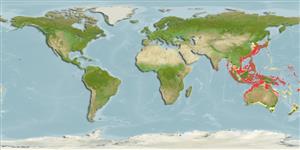Common names from other countries
Teleostei (teleosts) >
Perciformes/Serranoidei (Groupers) >
Anthiadidae (Fairy basslets or Streamer basses)
Etymology: Plectranthias: Greek, plektron = anyhting to strike with, spur + Greek, anthias = a fish, Sparus aurata (Ref. 45335).
More on author: Steindachner.
Environment: milieu / climate zone / depth range / distribution range
Ecology
Marine; demersal; depth range 156 - 320 m (Ref. 123579). Deep-water
Indo-West Pacific: Japan to Australia (Western Australia, Northern Territory); including Taiwan and southern Indonesia.
Size / Weight / Age
Maturity: Lm ? range ? - ? cm
Max length : 12.9 cm SL male/unsexed; (Ref. 123579); common length : 12.0 cm TL male/unsexed; (Ref. 9137)
Dorsal
soft rays
(total): 14-16;
Vertebrae: 26. This species is distinguished from its congeners by the following set of characters: segmented dorsal rays 1-16, usually 15; fourth or fifth dorsal spine longest; pectoral rays 15-17, usually 16; lateral line complete, with 30-35 tubed scales; posterior preopercle with 17-40 serrations, continued around corner of bone to posteroventral edge; no antrorse serrations on ventral edge of preopercle; margins of subopercle and interopercle serrate; scales with basal cteni; vertebrae 10+16 (Ref. 123579).
Inhabits deep trawling grounds to at least 200 m (Ref. 3132).
Life cycle and mating behavior
Maturity | Reproduction | Spawning | Eggs | Fecundity | Larvae
Gill, A.C., J.J. Pogonoski, G.I. Moore and J.W. Johnson, 2021. Review of Australian species of Plectranthias Bleeker and Selenanthias Tanaka (Teleostei: Serranidae: Anthiadinae), with descriptions of four new species. Zootaxa 4918(1):1-116. (Ref. 123579)
IUCN Red List Status (Ref. 130435)
CITES (Ref. 128078)
Not Evaluated
Threat to humans
Harmless
Human uses
Fisheries: commercial
More information
Common namesSynonymsMetabolismPredatorsEcotoxicologyReproductionMaturitySpawningFecundityEggsEgg development
ReferencesAquacultureAquaculture profileStrainsGeneticsElectrophoresesHeritabilityDiseasesProcessingMass conversion
Tools
Special reports
Download XML
Internet sources
Estimates based on models
Preferred temperature (Ref.
115969): 15.3 - 27.4, mean 23.9 (based on 404 cells).
Phylogenetic diversity index (Ref.
82804): PD
50 = 0.5000 [Uniqueness, from 0.5 = low to 2.0 = high].
Trophic level (Ref.
69278): 4.0 ±0.67 se; based on food items.
Resilience (Ref.
120179): High, minimum population doubling time less than 15 months (Preliminary K or Fecundity.).
Fishing Vulnerability (Ref.
59153): Low vulnerability (10 of 100).
